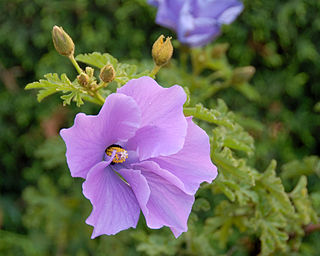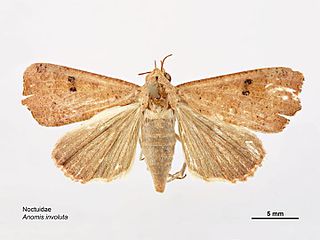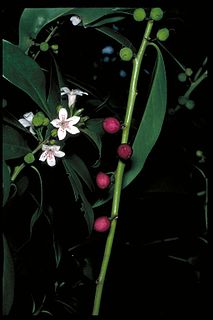
Hibiscus is a genus of flowering plants in the mallow family, Malvaceae. The genus is quite large, comprising several hundred species that are native to warm temperate, subtropical and tropical regions throughout the world. Member species are renowned for their large, showy flowers and those species are commonly known simply as "hibiscus", or less widely known as rose mallow. Other names include hardy hibiscus, rose of sharon, and tropical hibiscus.

Araucaria heterophylla is a vascular plant in the ancient and now disjointly distributed conifer family Araucariaceae. As its vernacular name Norfolk Island pine implies, the tree is endemic to Norfolk Island, a small island in the Pacific Ocean between New Zealand and New Caledonia, about 1,440 km (890 mi) east of Sydney, Australia but is cultivated elsewhere as an ornamental. The genus Araucaria occurs across the South Pacific, especially concentrated in New Caledonia where 13 closely related and similar-appearing species are found. It is sometimes called a star pine, Polynesian pine, triangle tree or living Christmas tree, due to its symmetrical shape as a sapling, although it is not a true pine.

Lord Howe Island is an irregularly crescent-shaped volcanic remnant in the Tasman Sea between Australia and New Zealand, 600 km (320 nmi) directly east of mainland Port Macquarie, 780 km (420 nmi) northeast of Sydney, and about 900 km (490 nmi) southwest of Norfolk Island. It is about 10 km (6.2 mi) long and between 0.3 and 2.0 km wide with an area of 14.55 km2, though just 3.98 km2 of that comprise the low-lying developed part of the island.

Hibiscus tiliaceus is a species of flowering tree in the mallow family, Malvaceae, that is native to the Old World tropics. Common names include sea hibiscus, beach hibiscus, coastalhibiscus, coastalcottonwood, green cottonwood, native hibiscus, native rosella, cottonwood hibiscus, kurrajong, sea rosemallow, balibago (Tagalog), malabago or malbago, maribago, waru (Javanese), baru or bebaru (Malay), pagu (Chamorro), hau (Hawaiian), fau (Samoan), purau (Tahitian), and vau tree. The specific epithet, "tiliaceus", refers to its resemblance of the leaves to those of the related Tilia species.

Phillip Island is an island located 6 km (3.7 mi) south of Norfolk Island in the Southwest Pacific, and is part of the Norfolk Island group. It was named in 1788 by Lieutenant Philip Gidley King after Arthur Phillip, the first Governor of New South Wales. Phillip Island is part of the Australian external territory of Norfolk Island, and is included in Norfolk Island National Park, as is neighbouring Nepean Island and about 10 percent of Norfolk Island proper.

Norfolk Island National Park is a protected area of 6.50 km2 (2.51 sq mi) located at 29°2′0″S167°56′59″E in the South Pacific Ocean, about 1,471 kilometres off the East coast of Australia. The park’s area includes the Mount Pitt section on the namesake Norfolk Island with an area of 4.60 km2 (1.78 sq mi) / 460 ha, as well as the neighboring Phillip Island encompassing 1.90 km2 (0.73 sq mi) / 190 ha, and the much smaller Nepean Island. The Norfolk Island group is a Commonwealth of Australia external territory, and is the only place in the world where the Norfolk Island parakeet and the white-chested white-eye occur.

Lagunaria is a monotypic genus in the family Malvaceae. It is an Australian plant which is native to Lord Howe Island, Norfolk Island and parts of coastal Queensland. It has been introduced to many parts of the world. The genus was named for its resemblance to the earlier genus Laguna Cav., which was named in honour of Andrés Laguna, a Spanish botanist and a physician to Pope Julius III.

Correa reflexa, commonly known as common correa or native fuchsia, is a shrub which is endemic to Australia.

The Lord Howe gerygone or Lord Howe gerygone flyeater was a small bird in the family Acanthizidae, brown and greyish in color. Its head was brown apart from a pale grey eye-ring and a grey throat and chin, many parts of the animal varied to the colour of yellow, this being apparent in its bright yellow belly. It made its home in the canopies of the island's forest until the early 20th century. The bird has had a variety of monikers: locally, it was known as the "rain-bird" due to its activity after the rains, or the "pop-goes-the-weasel", due to the similarity of its song to the well-known tune. The bird was endemic to Lord Howe Island in the Tasman Sea. There have been no records of the species since 1928, and it is considered to be extinct. Its extinction is almost certainly due to predation by black rats which were accidentally introduced to the island in 1918 following the shipwreck of the SS Makambo there.

Alyogyne huegelii is a flowering plant found in the Southwest botanical province of Western Australia, extending along its entire coastline. A large flowered shrub, the species favours the sands of coastal shrublands and heath.
Abutilon julianae is a small shrub of the genus Abutilon believed endemic to Norfolk Island and nearby Phillip Island. It was first recorded on Norfolk Island in 1792 by convict artist John Doody, and on Phillip Island by Ferdinand Bauer in 1804-05 where he collected the type specimen. It appears not to have been recorded on Phillip Island after 1804-05 and on Norfolk Island was last seen about 1912. For more than seventy years it was considered extinct, apparently killed out by grazing stock.

Hibiscus diversifolius, the swamp hibiscus, is a widespread species of hibiscus. It grows to between 1 and 2 metres in height, with prickly stems and yellow flowers with a maroon basal spot during spring summer.

Meryta latifolia, commonly known as broad-leaved meryta or shade tree, is an evergreen tree endemic to Norfolk Island, Australia, where it occurs in subtropical moist forest conditions.

The Conservatoire botanique national de Brest is a notable botanical garden located at 52 Allée du Bot, Brest, Finistère, in the region of Brittany, France. It is open daily without charge.

The Norfolk robin, also known as the Norfolk Island scarlet robin or Norfolk Island robin, is a small bird in the Australasian robin family Petroicidae. It is endemic to Norfolk Island, an Australian territory in the Tasman Sea, between Australia and New Zealand.

Anomis involuta, the jute looper or hibiscus cutworm, is a moth of the family Erebidae. It has a wide distribution, including the Cook Islands, Hong Kong, Japan, Korea, the Society Islands and Australia. It is also known from Kenya and Somalia.

Austroderia richardii, syn. Cortaderia richardii, is a species of flowering plant in the family Poaceae. It is an evergreen perennial grass. The genus Austroderia is often called "pampas grass", though this name usually refers to A. selloana. "Early pampas-grass" is a more specific name. The name "tussock grass" may also be found. The Maori name is "toetoe". It is one of five species in the genus Austroderia that are endemic to New Zealand. It occurs in the South Island and possibly also in the North Island. It is also an introduced species in Tasmania, Australia.

Boehmeria australis is a critically endangered large shrub species in the plant family Urticaceae. It is endemic to small islands of Australia and New Zealand.

Myoporum obscurum, commonly known as popwood, sandalwood or bastard ironwood is a plant in the figwort family, Scrophulariaceae. It is a very rare shrub, endemic to Norfolk Island where it occurs in a few scattered locations.

Eucalyptus insularis, commonly known as Twin Peak Island mallee, or North Twin Peak Island mallee, is a species of mallee that is endemic to a small area of southern Western Australia. It has mostly smooth bark, dull green, linear adult leaves, flower buds in group of between nine and twenty or more, white flowers and barrel-shaped fruit.



















